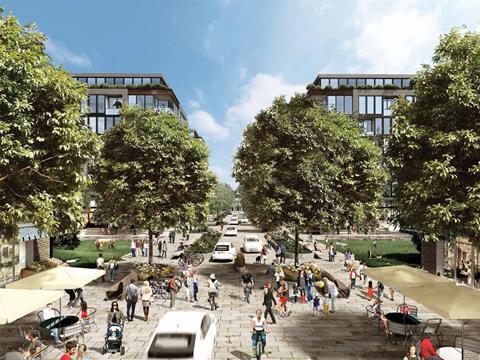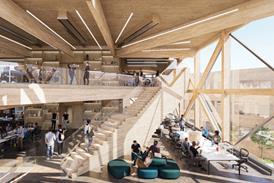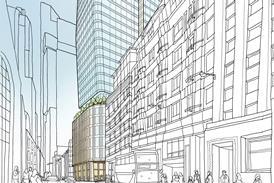Driverless cars could reshape our cities for better or worse. It’s up to us to decide how, says Ben Flatman

At some point in the middle of the 20th century – perhaps starting slightly earlier in the US – most developed economies made a collective decision to surrender their urban environment to the automobile. The rest of the world has not been far behind. Almost without exception, streets everywhere are dominated by cars. Even where the visual and leisure amenity of streets has not been completely lost, it has been profoundly degraded.
Across the world, almost without exception, priority has been given to cars. During the height of the UK road building boom, London was left permanently scarred by the Westway and elevated sections of the A4, while Glasgow was literally bisected by the M8. Some British cities like Coventry and Birmingham, centres of the automotive industry, were almost entirely rebuilt specifically to cater for and encourage car use. Every town and village has seen the quality and character of its streets utterly changed by ever growing amounts of traffic.
Many people were not happy about the urban design impact of the car. John Betjemen and Osbert Lancaster once warned about the blight of poorly designed and proliferating traffic signage. Such concerns now seem like an echo from a distant past. Pelican crossings, traffic lights and reflective signposts litter almost every high-street in the UK, to the extent that we barely notice their dire impact. When not in use, cars squat on tarmacked-over front gardens and turn streetscapes into permanent linear carparks. This also has become the accepted norm.

The world is now on the brink of a new transport revolution, with potentially huge implications for our built environment. Driverless vehicles, if they become as ubiquitous as promised, are likely to change our streets in ways both predictable and unimagined. It’s essential that the assumptions and responses that underlie this as yet un-built future are not left as unchallenged and poorly designed as were those underpinning the rise of the car.
One of the biggest challenges at the moment, as with the advent of all new technology, is trying to predict the impact of driverless vehicles. For every futurologist predicting fewer cars and the streets returned to the people, there is another pointing towards a disturbing flip side of exponential traffic growth and massively increased urban sprawl.
Technology including ride-sharing and navigational apps is already radically changing how we understand and experience the city. GPS is eroding peoples’ knowledge of their environment, as mental or physical street maps of places are no longer required. Car-pooling in the US, intended as a way to reduce traffic congestion, has in parts of New York actually increased the number of journeys, as it makes travelling by car accessible and affordable for those without one. What will driverless vehicles add to this mix?
As always with major transport revolutions, concepts of distance, time and urban space have the potential to be reimagined. Sleeping on long haul flights has long been standard, but never a possibility for drivers. As drivers become robots, we all become passengers, with journeys freed up for work and leisure. The orientation and interior design of cars will likely need to be reimagined. A standard 4 seater saloon car might come to resemble a cross between a bedroom, office and living room.
Distances and journey times from work might become irrelevant, as commuters sleep, perhaps even increasingly just live, in their cars
If car passengers don’t have to be awake as they travel to work, much greater commuting distances suddenly become more viable. The implications for further urban sprawl, especially in places with relaxed planning regimes, are potentially mind boggling. As the UK seems increasingly to be moving towards the dismantling of the post-war planning system and its protected green belts, the possibilities, and potential profits, for house builders and road construction firms are immense. Distances and journey times from work might become irrelevant, as commuters sleep, perhaps even increasingly just live, in their cars.
Marshall Brown, a US architect and academic has been developing a range of scenarios as part of the Driverless City project at the Illinois Institute of Technology. For Brown, these are not necessarily worrying, or even new ideas. The car provides an almost uniquely social function in the US. Drive-through restaurants and drive-in open air cinemas were once ubiquitous in the early post-war era, when the car was at the height of its romantic sway over American society. Brown believes a driverless future “could lead to the renaissance of the car as a social space.” He predicts that cars will not only provide a flexible physical space for their ride-sharing occupants, but also become increasingly interconnected with each other to create a huge network of moving, shifting social interaction.
Brown believes that current predictions tend towards extremes of utopia and dystopia and argues for a more balanced debate. In particular, he believes that society collectively needs to avoid accepting a deterministic outcome from the advent of driverless vehicles: “The future is not something that is just going to fall on our heads. We have to decide what kind of streets we want.” His scenarios try and imagine the impact on a range of vehicle-related activities, from commuting to parking and how these might change our cities.

What for instance happens if we no longer need our car parked nearby or perhaps have no need for our own car at all? The economics of real estate might be transformed. The average car in the US is in use only 5% of the time. This means that one expensive asset (a car) spends most its time parked unproductively on another expensive asset (land) doing nothing. It now seems entirely possible that actually owning a car will become economically pointless. While a status-conscious elite might still opt to have a car for their own exclusive use, why would most people bother in a future where they can access a driverless vehicle in minutes for a fraction of the cost?
The possible loss of demand for on and off street parking could free up a huge proportion of development land for new housing (or other uses). If garages and street parking become increasingly redundant, could pavements become broader and existing streetscapes be repurposed as green spaces? And let’s not forget the opportunities for getting rid of unsightly traffic signage, as driverless vehicles navigate digitally.
A decline in personal car ownership doesn’t necessarily mean fewer cars however. Car manufacturers themselves, or new entrants into the market, might become the predominant owners and operators of driverless vehicles. And parking is still likely to be required somewhere, for off-peak times. In recognition of the more dystopian impact there might be on urban-economics, Brown speculates that parking might be increasingly ‘off-shored’ to lower income areas.
The potential benefits, and pitfalls, of a driverless future are immense. As with other digital technologies, such as phones, dependence can be accompanied by the dangers of passively allowing technology to redefine how we live and think. We cannot leave road and traffic etiquette to the algorithms. The behaviours of driverless vehicles – how they navigate the city and where they go when they’re not being used, will define the way in which people experience the city of the future.
If the global rise and eventual domination of the car was met with a mixture of passivity, and sometimes disastrously over enthusiastic road engineering, then it’s essential that we learn from past lessons in order to confront the driverless world that now seems to be racing towards us. As architects, we must seek to actively shape that driverless future.
















No comments yet